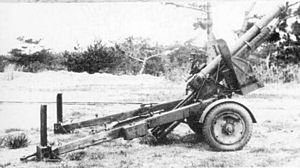Type 91 10 cm howitzer
| Type 91 10 cm Howitzer | |
|---|---|
 Type 91 10 cm Howitzer | |
| Type | light howitzer |
| Place of origin | |
| Service history | |
| In service | 1931-1949? |
| Used by | |
| Wars | Second Sino-Japanese War Soviet-Japanese Border Wars World War II Chinese Civil War |
| Production history | |
| Designed | 1927-1931 |
| Manufacturer | Osaka Arsenal |
| Produced | 1931-? |
| No. built | 1,100 |
| Specifications | |
| Mass | 1,500 kilograms (3,300 lb)[1] |
| Barrel length | 2.54 metres (8 ft 4 in) L/24 |
| Shell | 15.7 kilograms (35 lb) |
| Caliber | 100 millimetres (3.9 in) |
| Recoil | hydropneumatic |
| Carriage | split trail |
| Elevation | -5° to +45° |
| Traverse | 40° |
| Rate of fire | 6-8 rpm |
| Muzzle velocity | 546 m/s (1,791 ft/s) |
| Maximum firing range | 10,771 metres (11,779 yd) |
| Feed system | panoramic |
The Type 91 10 cm Howitzer (九一式十糎榴弾砲, Kyūisshiki Jissenchi Ryudanho) was a howitzer used by the Imperial Japanese Army during the Second Sino-Japanese War and World War II.
History and development
The Type 91 10 cm Howitzer was an orthodox design howitzer, based largely on contemporary French Canon de 105 mle 1913 Schneider howitzers ordered during the late 1920s by the Japanese Army Technical Bureau for evaluation purposes. It was intended to supplement, and eventually supersede the largely obsolete Type 38 15 cm howitzer, which had been in service since the end of the Russo-Japanese War. Over one thousand units were produced beginning in 1931.
Design
The Type 91 10 cm Howitzer had a hydropneumatic recoil mechanism, split trail, and interrupted screw breech mechanism. It was designed to be towed by a team of six horses.[2]
The Type 91 fired a 15kg standard high-explosive shell, up to 10,500 metres and could also fire chemical, armor-piercing, and shrapnel shells.[3]
Variants
Early models of the Type 91 had wooden spoked wheels, but later versions had steel wheels with pneumatic tires for towing behind a motorized transport at the cost of an extra 250 kilograms (550 lb).
Combat record
Type 91 10 cm Howitzer was used in large numbers in from line combat service from the time of the invasion of Manchuria through the Soviet-Japanese Border Wars, the Second Sino-Japanese War and in most fronts during the Pacific War. The Type 91 was typically assigned to field artillery regiments together with 75mm field guns.[4]
Weapons captured by the Chinese during the Second Sino-Japanese War, or abandoned in China at the time of the surrender of Japan, were placed into service by both the National Revolutionary Army of the Nationalist government and the People's Liberation Army of the Chinese communist government through the Chinese Civil War.
References
- Bishop, Chris (eds) The Encyclopedia of Weapons of World War II. Barnes & Nobel. 1998. ISBN 0-7607-1022-8
- Chamberlain, Peter and Gander, Terry. Light and Medium Field Artillery. Macdonald and Jane's (1975). ISBN 0-356-08215-6
- Chant, Chris. Artillery of World War II, Zenith Press, 2001, ISBN 0-7603-1172-2
- McLean, Donald B. Japanese Artillery; Weapons and Tactics. Wickenburg, Ariz.: Normount Technical Publications 1973. ISBN 0-87947-157-3.
- Mayer, S.L. The Rise and Fall of Imperial Japan. The Military Press (1984) ISBN 0-517-42313-8
- US Department of War, TM 30-480, Handbook on Japanese Military Forces, Louisiana State University Press, 1994. ISBN 0-8071-2013-8
